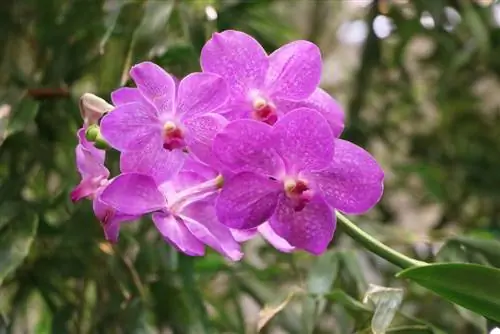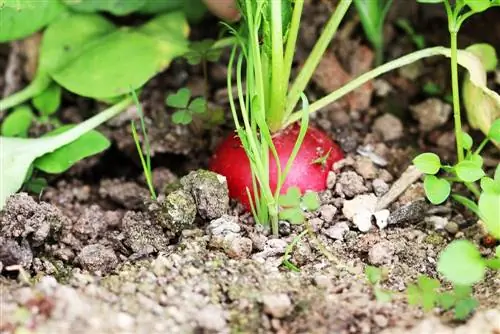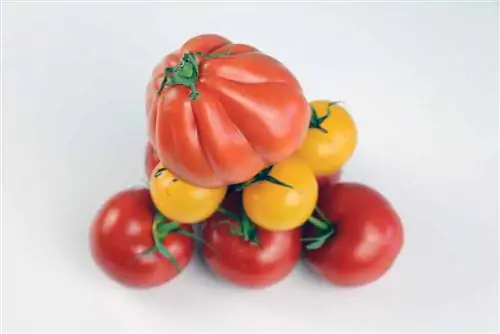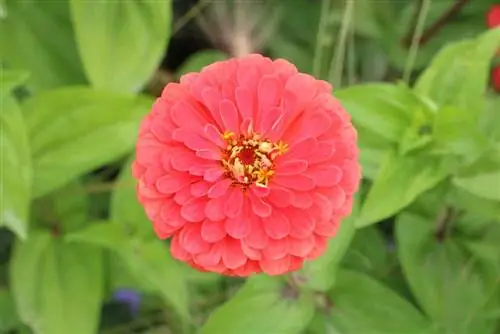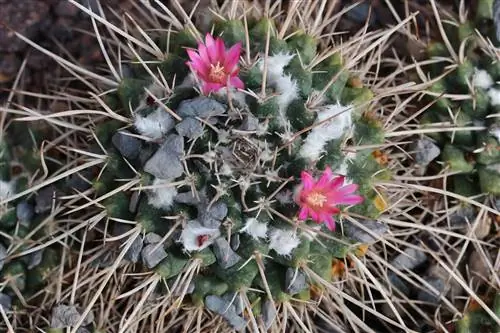- Author admin [email protected].
- Public 2023-12-17 03:39.
- Last modified 2025-01-24 12:45.
Many households here have orchids, and these are usually the Phalaenopsis variety, which is mainly offered in the many hardware stores and discounters. But anyone who knows a little about orchids knows that there are around 20,000 species here. In order to give a better picture of the different varieties that are also popular with connoisseurs, this short list was created.
Brassia
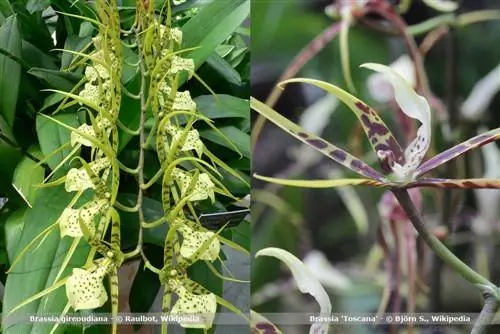
The bizarre flowers of this type of orchid often make the viewer of this plant not immediately think of an orchid. Because its appearance is very unusual for an orchid, with its elongated petals and rather bizarre-looking flowers. In these latitudes, the Brassia is also known as the spider orchid due to its spider-like appearance. This species is an epiphyte, so the following care is recommended:
- bright and warm location
- no direct sun
- originally native to the Caribbean
- also in Mexico, Guatemala or Honduras
- needs lots of fresh air
- without drafts
- high humidity
- Epiphyte plant, does not require soil
- overgrown with moss on branch, sit
- can grow very tall with climbing aid
The Brassia is characterized by the fact that the inflorescences are racemose and the long leaves are smooth and blunt at the tip. The flowers are yellow, light green or white with a lip that resembles a tongue.
Tip:
For all types of orchids, it is important that the rest periods are observed after new growth, during which the plants are moved to a cooler place, not fertilized and only watered moderately. Otherwise the orchids could react very sensitively.
Burrageara Nelly Isler
The Burrageara is not a natural species of orchid, it was created from crosses between different orchid species, including Oncidium and Miltonia. The name therefore comes from Albert C: Burrage, who was the first to study these crossings. The appearance and care of the Burrageara Nelly Isler is explained below:
- red bright flowers with yellow center
- exude a pleasant rose-like scent
- Flower stems grow up to 60 cm high
- a single flower is about five centimeters tall
- the flowering is not tied to a specific time
- cut off wilted stems
- a new flower stalk follows immediately
- high humidity
- bright, warm location
The Burrageara Nelly Isler is well suited for indoor cultivation, but can also be moved outdoors to a protected location in the warm summer. The different temperatures between day and night are particularly good for the plant. Regularly dipping the roots makes more sense than watering, and the orchid should also be sprayed regularly. Direct sunlight should be avoided despite the bright location.
Cambria

The Cambria orchid is not a naturally occurring species, but is the result of breeding. The Cambria is based on many different genera of orchids, so that it is often referred to as a cosmopolitan globetrotter. This species was “born” for the first time in 1931; it is a very young orchid variety. The Cambria is quite easy to care for and its appearance is striking:
- Flowers red with contrasting color
- Flower stems grow up to 60 cm high
- is framed by green, lancet-like leaves
- can be cultivated continuously at room temperature
- around 25° Celsius is ideal
- A little cooler in winter
- can go outdoors in summer
- Protect from the sun at every location
- spray regularly
- water and fertilize regularly
Tip:
The Cambria is very easy to care for and is particularly suitable for orchid beginners due to its simplicity.
Cattleya
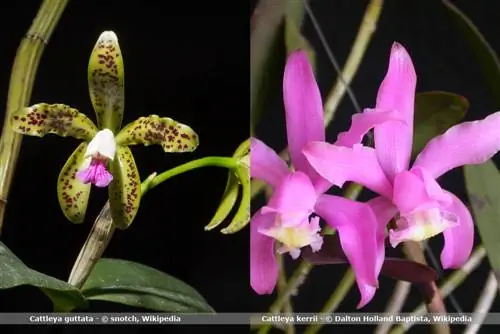
The Cattleya genus originally comes from South America and predominantly from southern and eastern Brazil and the Andes. Here these orchids live as planting plants on rocks or trees. The species can grow up to 90 cm high and should therefore be supported with a trellis. The colorful and striking flowers fascinate every orchid lover. The plant has the following characteristics and the following should be taken into account when caring for it:
- big flowers
- with oval sepals
- wider petals
- three-lobed frayed lip
- spotted in brown, white, green, yellow or red
- Difference between one and two leaf plants
- Flowering between January and March
- Location bright, warm without direct sun
- also protected outdoors in summer
- dip and fertilize regularly
During the growth phase, the orchid should be kept warm and receive sufficient water and fertilizer. During the dormant phase, water only moderately, as the plant will then be colder. Fertilizer should be avoided completely during this time.
Cymbidium
The name of this type of orchid comes from Greek and is derived from the word kymbós, which translates as boat or flat boat. The name describes the appearance of Cymbidium quite well, because with a little imagination you can really see a small ship in the strong lip. The genus Cymbidium originally comes from India, Thailand, Vietnam or Burma. These orchid species have also been found in Australia. These varieties are very popular with expert orchid collectors:
- Flowering period from autumn to spring
- Blossoms last a very long time
- are popular as cut flowers
- exude a pleasant scent
- Pink, yellow, green, white or red
- multi-flowered, upright, 40 cm long shoots
- can cope with nighttime temperature fluctuations of 20° Celsius
- so suitable for outdoor use in summer
- does not require a pronounced rest phase
- fertilize and water regularly
Tip:
Cymbidium orchids require high humidity and a bright location. Therefore they are ideal to cultivate in a bright bathroom.
Women's shoes
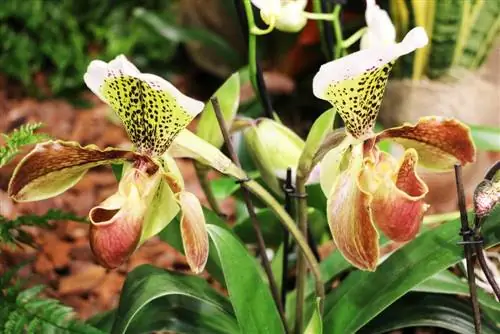
The lady's slipper orchid species gets its scientific name Paphiopedilum in honor of Aphrodite, who rose from the sea near what is now the Cypriot city of Paphos. Nevertheless, the homeland of this variety is far from Cyprus in Thailand, China, Malaysia, Indonesia and the Philippines. However, this species owes its German name primarily to its appearance. The flowers are reminiscent of a shoe that is open at the back and closed at the front. Since the lady's slipper is used to shade, especially in its original locations, it must not be exposed to the sun and a north-facing window is preferred in the apartment. Other features and care instructions as follows:
- multi-flowered
- New sprouts are formed from rhizomes
- Flower buds at the end of a shoot
- various types available
- differ from three types of leaves
- spotted
- green and narrow
- green and wide
- all species need to be cared for differently
- ask when buying in stores
The special thing about this type of orchid is that it needs soil to grow. Unlike the other orchid varieties that either require orchid substrate or are cultivated as planters, the lady's slipper is an orchid that requires soil with a pH between 5.0 and 6.5.
Tip:
The lady's slipper orchid variety is very popular in this latitude, but it must be pointed out that the plant is slightly poisonous and can trigger a contact allergy.
Ludisia
The Ludisia variety, like the lady's slipper, also spreads via rhizomes and should therefore also be cultivated in soil. It unfolds like many ground cover plants do. This type of orchid is originally native to India, southern China and the Philippines. Ludisia grows best here in the shade of large trees. A shady place should also be chosen for this type of orchid in the living room at home. Even without flowers, this is a decorative ornamental plant. The Ludisia has these other characteristics and requires the following care:
- Intense coloring of the leaves
- Sunlight bleaches them
- still bright location
- does not require typical rest periods
- loves a warm location all year round
- Pouring and dipping are equally permitted
- normal potting soil mixed with sand
- fertilize regularly
- can be easily propagated
Tip:
To allow enough light to reach the orchid roots, you can also choose a transparent container. This improves the metabolism of the plants.
Masdevallia
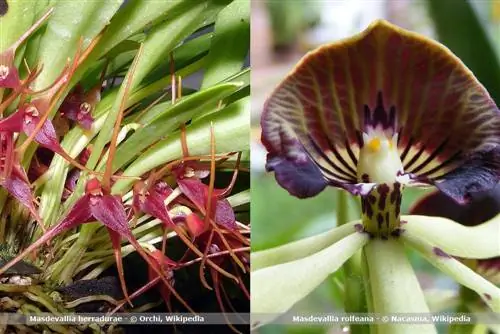
The orchids of this species are still exotic in these latitudes, which is actually a shame. Because with their spectacular flowers they often attract admiring glances. However, these varieties are not suitable for beginners because they require a certain amount of sensitivity and experience in handling. The Masdevallia is originally native to the Andes and Mexico. It particularly prefers high altitudes above 2000 meters and grows here on rocks or trees. Therefore, this is also a planter plant that does not require a pot of soil when cultivated in the living room. This species is particularly characterized by the following characteristics and care:
- round-oval shape of the leaves
- Flowers triangular shaped
- 50 cm high stems as ears
- individual flowers are also normal
- Colors between red, violet, pastel red, orange and yellow
- do not have a resting period, flowers spread throughout the year
- cool location without direct sun
- outdoors in summer
- high humidity
- only use rainwater
The colder the Masdevallia is, the less it needs to be watered or dipped. In order to maintain the desired high humidity, in addition to setting up a humidifier, you can also spray it daily.
Tip:
In order to prevent the roots of planter plants from drying out, they are ideally wrapped with sphagnum moss, which has good moisture storage qualities.
Oncidium
This planter, like many others, originally comes from the high altitudes of Central and South America. The orchid genus Oncidium particularly prefers the moist rainforests here. However, this genus still has to be divided into two categories, because some like it warmer, others prefer it colder. This should be clarified directly when purchasing from a well-stocked specialist retailer. The bizarre flowers delight many orchid connoisseurs; care is recommended as follows:
- after the Greek word onkos=bulge or callus
- Bulge at the base of the lips of the flowers
- branched flower stems with many flowers
- grow out below the pseudobulb
- Flower color usually brown or yellow
- Incompatible with limescale
- water only with rainwater
- Bright location without direct sun
- requires orchid soil
- water and fertilize regularly
Tip:
A pseudobulb, a term that is often used in connection with orchids, refers to individual stems from which the leaves emerge.
Phalaenopsis
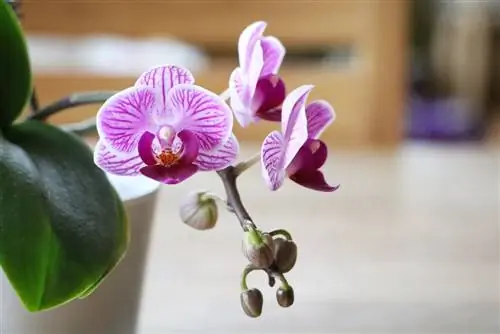
As already mentioned in the introduction, this genus is the most widespread and well-known species. Beginners usually start with this orchid variety. The Greek name here is made up of moth (phalaina) and appearance (opsis), which already describes this orchid well. As with any other orchid, there are a few things that need to be taken into account when caring for them. Appearance and care instructions:
- leather-like texture
- Inflorescences between the leaves
- also directly on the leaf axis
- Flower with three petals and three sepals
- in the center the stamen
- always use special orchid soil
- spray regularly with water from above
- dip the root ball in water every one to two weeks
- Location warm and bright
- cooler in winter
Tip:
Almost all types of orchids want very loose soil; the roots must not be pressed into the soil. If commercial orchid soil is not used, a coarsely structured bark substrate is also suitable.
Zygopetalum

The orchid species Zygopetalum is a challenge. Not only does it stand out from other orchids in terms of appearance, but it also requires a lot of effort and special requirements when it comes to care. This genus originally grows in the rainforests of Brazil. Since these plants are very susceptible to fungi, they should not be sprayed directly. It is better to cultivate them in a damp room or even in a display case with the necessary humidity. In addition, this type of orchid does not tolerate any sunlight and is more sensitive to it than other types of orchids. Further features and care instructions:
- Flowers mostly purple or blue
- various varieties with small or large flowers
- blue orchids very rare
- Sprouts grow from side axes
- Inflorescences up to 60 cm long
- upright or hanging
- forms quite thick roots
- Location slightly dark
- Make sure there is enough air supply in the display case
- fertilize and water regularly
Tip:
Despite extensive care, the Zygopetalum varieties have become increasingly popular in these latitudes in recent years.

